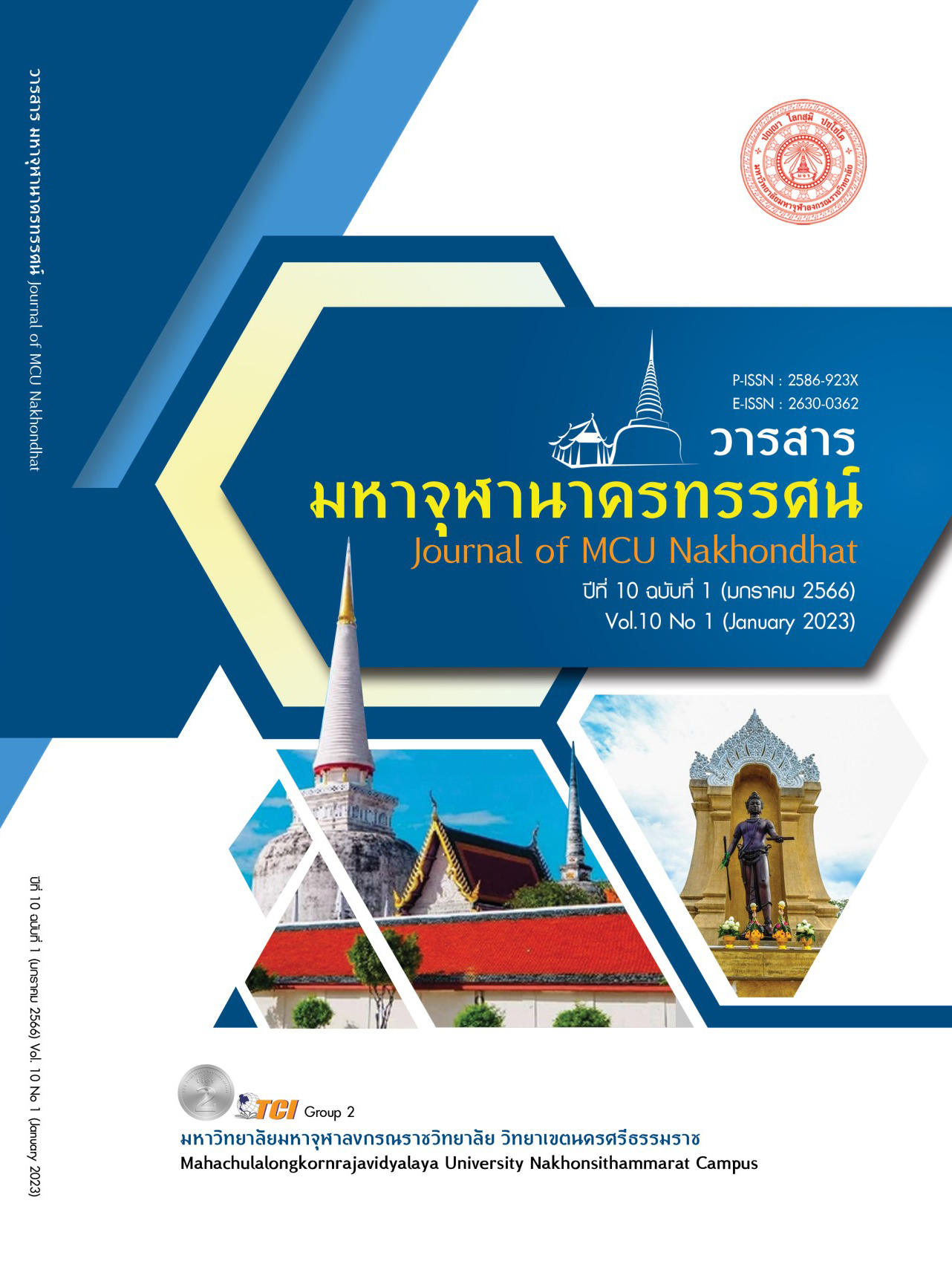THE BODHISATTVA BELIEF OCCURRED DURING KING PRASAT THONG'S REIGN
Main Article Content
Abstract
The purpose of this academic article was to investigate the Bodhisattva belief that occured during King Prasat Thong's reign by studying texts from Ayutthaya period literature on chanting words in honor of the Phra Bhuddha Chao Luang Prasat Thong. The study showed that Bodhisattva was a concept that originated in India before the time of the Buddha and had its roots in political and religious heroes. It was a belief in Theravada and Mahayana Buddhism. They had different meanings; in Theravada Buddhism, "Bodhisattva" meant that the person could accumulate merit to become the Buddha in the future. In Mahayana Buddhism, all Buddhists, not just one, could accumulate enough merit to become Buddha. Furthermore, he held the Bodhisattva's beliefs close to his heart.As a result, he performed royal duties for the country's peace and tranquility. People were happy without suffering. In this study, new findings were obtained. Previously, it was thought that the Ayutthaya monarch was the model that adopted the Khmer Empire's concept of Devaracha and brought absolute monarchy to the Ayutthaya Kingdom. As a result, His Majesty's image is a hypothetical deity according to the concept of Devaracha. From the study, it was found that the Ayutthaya monarchs used the concept of Thewaracha only as a model for governing the Ayutthaya Kingdom, but that his heart was filled with the grace that comes from the belief of the Bodhisattva. The King performed royal duties that were of great benefit to the country and the people. Considering all of these, King Prasat Thong was the representative of the Ayutthaya monarchy.
Article Details

This work is licensed under a Creative Commons Attribution-NonCommercial-NoDerivatives 4.0 International License.
References
ประพจน์ อัศววิรุฬหการ. (2557). โพธิสัตว์จรรยา : มรรคาเพื่อมหาชน. (พิมพ์ครั้งที่ 2). กรุงเทพมหานคร: โครงการเผยแพร่ผลงานวิชาการ คณะอักษรศาสตร์ จุฬาลงกรณ์มหาวิทยาลัย.
ปรียา หิรัญประดิษฐ. (2549). การศึกษาวรรณคดีสมัยอยุธยา. นนทบุรี: โรงพิมพ์มหาวิทยาลัยสุโขทัยธรรมาธิราช.
พระปรีชา เถี่ยนกือ (โพธิ์เงิน). (2561). แนวทางการเสริมสร้างความเป็นโพธิสัตว์บนฐานจริยธรรมของ พระพุทธศาสนามหายานตามแนวพุทธจิตวิทยา. ใน ปริญญาดุษฎีพุทธศาสตรดุษฎีบัณฑิต สาขาวิชาพุทธจิตวิทยา. มหาวิทยาลัยมหาจุฬาลงกรณราชวิทยาลัย.
พระพรหมคุณาภรณ์ (ป.อ. ปยุตฺโต). (2554). พจนานุกรมพุทธศาสน์ ฉบับประมวลศัพท์. (พิมพ์ครั้งที่ 16). กรุงเทพมหานคร: โรงพิมพ์บริษัท สหธรรมิก.
พระมหาราชครู. (2545). คำฉันท์สรรเสริญพระเกียรติสมเด็จพระพุทธเจ้าหลวงปราสาททอง. ใน วรรณกรรมสมัยอยุธยา เล่ม 3. กรุงเทพมหานคร: กรมศิลปากร.
พระราชพงศาวดารกรุงศรีอยุธยา ฉบับพันจันทนุมาศ (เจิม). (2553). และเอกสารอื่น. นนทบุรี: ศรีปัญญา.
พัฒน์ เพ็งผลา. (2552). ชาดกกับวรรณกรรมไทย. (พิมพ์ครั้งที่ 4). กรุงเทพมหานคร: มหาวิทยาลัยรามคำแหง.
ยุพร แสงทักษิณ. (2537). วรรณคดียอพระเกียรติ. กรุงเทพมหานคร: โรงพิมพ์คุรุสภาลาดพร้าว.
ราชบัณฑิตยสถาน. (2556). พจนานุกรมฉบับราชบัณฑิตยสถาน พ.ศ.2554 เฉลิมพระเกียรติพระบาทสมเด็จพระเจ้าอยู่หัว เนื่องในโอกาสพระราชพิธีมหามงคลเฉลิมพระเกียรติพระชนมพรรษา 7 รอบ 5 ธันวาคม 2554. กรุงเทพมหานคร: ราชบัณฑิตยสถาน.
ลิขิต ธีรเวคิน. (2544). หน่วยที่ 14 การเมืองการปกครอง พ.ศ.2516-2519 ใน ประวัติศาสตร์สังคมและการเมืองไทย หน่วยที่ 8-15 (พิมพ์ครั้งที่ 21). นนทบุรี: มหาวิทยาลัยสุโขทัยธรรมาธิราช.


